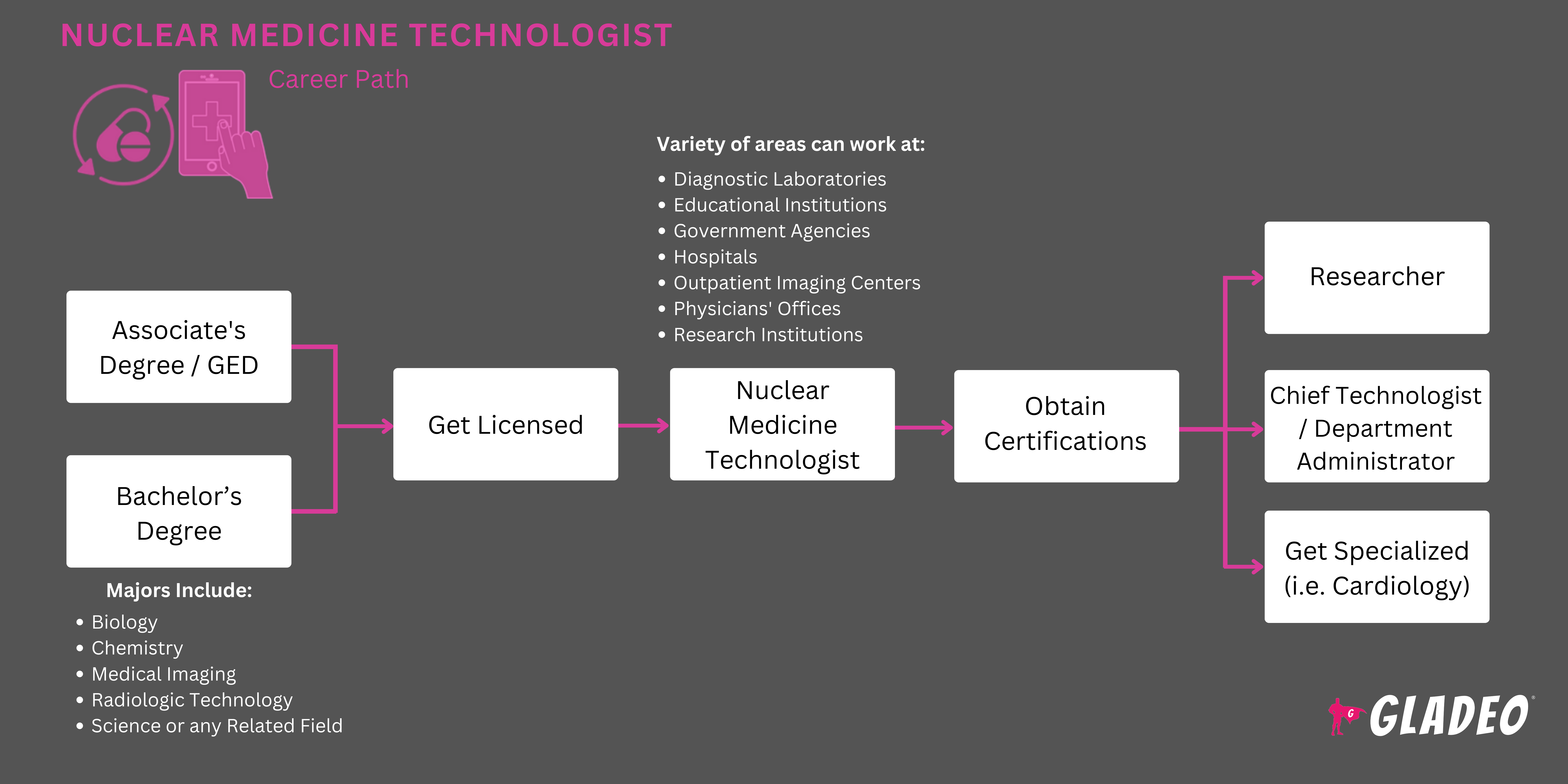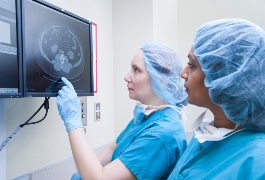Mga spotlight
Certified Nuclear Medicine Technologist (CNMT), Nuclear Cardiology Technologist, Nuclear Medicine PET-CT Technologist (Nuclear Medicine Positron Emission Tomography - Computed Tomography Technologist), Nuclear Medicine Technologist (NMT), Radiation Safety Officer, Registered Nuclear Medicine Technologist, Staff Nuclear Medicine Technologist
Maraming mga medikal na pagsusuri at therapy ang nangangailangan ng paggamit ng mga radioactive na gamot na tinatawag na radiopharmaceuticals na ibigay sa mga pasyente. Ang mga ito ay nagbibigay-daan sa mga espesyal na medikal na kagamitan sa imaging upang makita ang mga panloob na problema na maaaring masuri at magamot ng mga doktor. Ang mga Nuclear Medicine Technologist ay may pananagutan sa paghawak at pangangasiwa ng mga gamot na ito, at pagpapatakbo ng mga naaangkop na kagamitan. Direkta silang nakikipag-ugnayan sa mga pasyente upang maibsan ang mga alalahanin, at sa mga doktor at iba pang miyembro ng medikal na kawani upang magbigay ng suporta kung kinakailangan.
Dahil sa mapanganib na katangian ng radiopharmaceuticals, ang mga Nuclear Medicine Technologist ay tumatanggap ng partikular na pagsasanay sa kaligtasan upang matiyak ang kanilang sariling kaligtasan pati na rin ng mga pasyente. Dapat nilang bigyang-pansin ang anumang mga palatandaan ng masamang reaksyon sa mga ibinibigay na gamot. Sila rin ang namamahala sa pagpapanatili ng mga talaan. Sa pambihirang kaganapan ng isang sakuna, ang kanilang kaalaman at kadalubhasaan ay maaaring maging kwalipikado sa kanila na magsilbi bilang mga unang tumugon sa mga radioactive/nuclear na insidente sa kanilang pasilidad. Kadalasan ay nakakakuha sila ng sertipikasyon sa alinman sa positron emission tomography o nuclear cardiology.
- Nagsisilbi bilang mga kritikal na eksperto sa paksa sa loob ng mga setting ng pangangalagang pangkalusugan
- Pagtulong sa mga proseso ng diagnostic at paggamot para sa mga pasyenteng mahirap i-diagnose
- Paggawa gamit ang mga advanced na gamot at teknolohiya
- Aktibong nag-aambag sa nakapagliligtas-buhay na medikal na paggamot para sa mga pasyente ng cancer
Oras ng trabaho
- Ang mga Nuclear Medicine Technologist ay nagtatrabaho nang full-time, na may potensyal para sa mga shift sa gabi, katapusan ng linggo, at holiday. Ang trabaho ay maaaring pisikal na hinihingi, dahil sila ay nakatayo sa karamihan ng oras at kung minsan ay dapat tumulong sa iba na bumangon.
Mga Karaniwang Tungkulin
- Suriin ang mga pamamaraan at resulta sa mga pasyente at pamilya, kung naaangkop
- Ihanda at pangasiwaan ang mga radioactive na gamot nang may pag-iingat, upang mabawasan ang pagkakalantad
- Pisikal na tulungan ang mga pasyente na may limitadong paggalaw o kapag kinakailangan upang iposisyon ang mga ito nang tama para sa angkop na imaging
- Ilagay ang mga kagamitan o radioactive beam upang ilantad ang mga pasyente sa mga tamang lugar
- Tukuyin ang dosis at pangasiwaan ang mga radiopharmaceutical para sa imaging o paggamot; subaybayan ang mga palatandaan ng masamang reaksyon
- Gumamit ng computerized medical imaging machine upang makakuha ng diagnostic na impormasyon sa mga panloob na lugar ng problema; iproseso ang mga larawang natanggap pagkatapos subaybayan ang mga radiopharmaceutical path, pagkatapos ay suriin sa mga doktor
- Panatilihin ang kagamitan at tiyakin ang wastong paggana at kontrol sa kalidad
- Gumamit ng iba pang kagamitan sa lab upang siyasatin ang mga sample at specimen
- Idokumento ang mga aktibidad sa pamamaraan; mangolekta ng data at impormasyon sa kasaysayan ng pasyente
Mga Karagdagang Pananagutan
- Tiyakin na ang lahat ng mapanganib na basura ay maayos na itinatapon
- Makipagtulungan sa ibang mga medikal na kawani at sanayin sila kung kinakailangan
- Dagdagan ang mga standard operating procedure na may mga lokal na pagbabago
Soft Skills
- Mga kasanayan sa pagsusuri
- Habag at empatiya para sa mga pasyente at miyembro ng pamilya
- Cultural sensitivity at kamalayan
- Mabusisi pagdating sa detalye
- Napakahusay na mga kasanayan sa komunikasyon, kabilang ang kakayahang magsalita ng mga pamamaraan
- Independent
- Imbestigasyon
- Objectivity
- pasensya
- Pisikal na tibay
- Matatag at kayang tiisin ang stress
- Tamang paghuhusga at paggawa ng desisyon
Teknikal na kasanayan
- Kritikal na pag-iisip
- Kaalaman sa medikal at elektronikong medikal na record software
- Familiarity sa: automated external defibrillators, blood collection syringe, chart recorder, electrocardiography at electronic blood pressure unit, flow sensors o regulators o component, hypodermic needle, intravenous infusion pump, liquid scintillation counter, medical computed tomography calibration, gamma camera, printer, imager , darkrooms, daylight processor, at positron emission tomography
- Pamilyar sa: medical radiation dosimeters, single photon emission computed tomography, microcentrifuges, peripheral intravenous catheters, phantom dosimeters, pulse oximeter units, scintillation crystal assemblies, specimen collection container, spectrometers, at vacuum blood collection tubes
- Naaangkop na pag-unawa sa biology at medisina
- Kaalaman sa paggamit ng personal protective equipment
- Mga ospital
- Mga sentro ng pangangalaga sa labas ng pasyente
- Mga opisina ng manggagamot
- Mga lab na medikal/diagnostic
Gumagawa ang mga Nuclear Medicine Technologist sa mga radioactive na materyales kaya dapat magsanay ng mga protocol sa kaligtasan at magsuot ng protective gear upang maprotektahan ang mga ito mula sa nakakapinsalang pagkakalantad. Inaasahan din nila, natural, na panatilihing ligtas ang mga pasyente at bawasan ang pagkakalantad sa halaga at mga lugar na kinakailangan lamang.
Tulad ng anumang propesyonal sa pangangalagang pangkalusugan, palaging may panganib na malantad sa mga taong maaaring may nakakahawang sakit. Nasa tungkulin ng mga Nuclear Medicine Technologist na maging lubos na bihasa sa lahat ng aspeto ng kanilang propesyon, at maging handa na harapin ang mga emerhensiya kung sila ay dumating.
Ang mga Amerikano ay nabubuhay nang mas matagal (ngunit hindi kinakailangang mas malusog) at sa gayon ay nangangailangan ng higit pang mga serbisyo sa pangangalagang pangkalusugan. Ang mga Nuclear Medicine Technologist ay isa lamang sa maraming mga propesyon na mananatiling mahalaga sa nakikinita na hinaharap, lalo na dahil sa kanilang mataas na dalubhasang mga kasanayan. Ang mga pagsulong sa cardiology at oncology at mga pagbabago sa domestic production ng radioisotope Tc-99m ay nakaapekto sa larangan nitong mga nakaraang taon. Habang ang nuclear medicine mismo ay patuloy na umuunlad, ang mga eksperto sa larangan ng karera na ito ay kailangang manatiling napapanahon sa mga pagbabago at handang sanayin ang iba.
Ang mga Nuclear Medicine Technologist ay nagpapatakbo sa isang medyo bagong lugar ng medisina. Sila ay matanong tungkol sa pagtulak ng mga hangganan at ang gayong pag-usisa ay maaaring palaging bahagi ng kanilang pagkatao. Bilang karagdagan sa isang interes sa agham at biology, malamang na sabik din silang tumulong sa ibang tao, dahil iyon ang pangunahing dahilan sa likod ng halos lahat ng mga medikal na propesyon.
Sila ay independyente, tiwala, at matulungin sa detalye at kaligtasan. Malamang na palagi silang nasiyahan sa pagsunod sa mga pamamaraan at panuntunan, upang matiyak na ang mga bagay ay maayos na inaalagaan. Maaaring mayroon silang interes o hindi sa science fiction, at malamang na mayroon na silang praktikal, maaasahang streak mula pagkabata.
- Hindi bababa sa isang associate's degree sa Nuclear Medicine Technology ang kailangan para makapagsimula
- Ang isang bachelors sa biology, chemistry, radiologic technology, o nursing, at/o 12-buwang sertipikasyon ay maaaring maging lubhang kapaki-pakinabang at gawing mas mapagkumpitensya ka sa panahon ng mga aplikasyon sa trabaho
- Ang mga programa sa kolehiyo sa mga lugar na ito ay dapat palaging kinikilala ng Joint Review Committee sa Educational Programs sa Nuclear Medicine Technology.
- Kasama sa mga sertipiko mula sa American Registry of Radiologic Technologist o Nuclear Medicine Technology Certification Board ang:
- Positron Emission Tomography (PET)
- Nuclear Cardiology (NCT)
- Computed Tomography (CT)
- Ang ilang mga estado ay nangangailangan ng mga Nuclear Medicine Technologist na magkaroon ng lisensya
- Maghanap ng mga kolehiyo na nag-aalok ng mga programang may mataas na ranggo sa biology, chemistry, radiologic technology, o nursing
- Ang akreditasyon ng Joint Review Committee sa Educational Programs sa Nuclear Medicine Technology ay mahalaga para sa ilang employer
- Suriin ang mga ranking sa kolehiyo ng US News upang matuto nang higit pa tungkol sa mga paaralan at programa. Dahil lang sa pangkalahatang ranggo ng isang paaralan ay hindi nangangahulugan na ang isang partikular na programa ay ganoon din
- Tingnan ang lahat ng nauugnay na pahina sa website ng bawat paaralan, upang malaman ang tungkol sa mga istatistika ng pagpapatala, mga inisyatiba sa pagkakaiba-iba, halaga ng matrikula, mga iskolar, mga proyekto sa pananaliksik at pagpopondo, mga organisasyon ng mag-aaral, at mga alok sa career center
- Alamin ang tungkol sa mga miyembro ng faculty! Ang lahat ng mga propesor ay hindi pareho, kaya hanapin ang mga nanalo ng mga parangal o kung saan ang mga lugar ng pananaliksik ay nakakaakit sa iyo
- Subukang maghanap ng mga program na nagtatampok ng impormasyon tungkol sa mga karaniwang laki ng klase upang matiyak na makakakuha ka ng sapat na oras ng mag-aaral-guro
- Pag-isipang mabuti kung ang isang online o hybrid na programa ay tama para sa iyong iskedyul, o kung mayroon kang kakayahang dumalo sa campus at makakuha ng higit pang hands-on na pagsasanay
- Bago mag-apply, suriin ang mga rate ng pagtanggap at pagtatapos, at silipin ang mga istatistika ng pagkakalagay ng trabaho. Maraming mga paaralan ang may malakas na koneksyon sa kasosyo at nagsisilbing mga funnel para sa mga recruiter na naghahanap ng mga matalinong nagtapos
- Kakailanganin mong kumuha ng maraming kurso sa alinman sa high school at kolehiyo na may kaugnayan sa matematika, biology, anatomy, physiology, chemistry, computer science, physics, at radioactive na gamot
- Sa ilang mga punto alinman sa kolehiyo o sa panahon ng isang programa ng sertipikasyon, asahan na makatanggap ng praktikal na hands-on na klinikal na karanasan sa nuclear medicine
- Isaalang-alang ang paggawa ng internship upang makakuha ng karanasan sa trabaho sa mga setting ng pangangalagang pangkalusugan
- Maghanap ng mga pagkakataong boluntaryo na naglalantad sa iyo sa pakikipagtulungan sa mga pasyente sa mga klinikal na setting
- Magtrabaho sa iyong propesyonal na network at sumali (o hindi bababa sa alamin ang tungkol sa) mga organisasyon tulad ng:
- American Society of Radiologic Technologists (ASRT)
- Central Chapter ng Society of Nuclear Medicine and Molecular Imaging (CCSNM)
- Lipunan ng Nuclear Medicine at Molecular Imaging (SNMMI)
- American Society of Nuclear Cardiology
- Radiological Society ng North America
- Lipunan ng Radiopharmaceutical Sciences
- World Molecular Imaging Society

- Tapusin ang mas maraming edukasyon hangga't maaari bago mag-apply, upang maging mapagkumpitensya
- Mag-apply lamang kung natutugunan mo ang lahat ng nakalistang kwalipikasyon sa advertisement ng trabaho
- Magsumite ng isang pinakintab na resume na naglilista ng mga detalye tungkol sa iyong scholastic, trabaho, at extracurricular na mga nagawa
- Ang bawat linya ay dapat na suportado ng data, istatistika, halaga ng dolyar, at/o epekto
- Mag-sign up para sa mga alerto sa trabaho sa Indeed.com, Monster, Glassdoor, at mga nauugnay na portal ng trabaho. Maaari mo ring gamitin ang Google Careers
- Punan ang iyong buong profile sa LinkedIn at mag-imbita ng mga koneksyon! Bawat CNBC, hanggang 80% ng mga trabaho ay matatagpuan sa pamamagitan ng paggamit ng iyong network sa mga araw na ito
- Kung magagawa, gumamit ng propesyonal na editor o resume writer!
- I-highlight ang mga keyword sa mga ad ng trabaho at gamitin ang mga ito sa iyong sariling resume. Makakatulong ito na malampasan ang mga palihim na filter ng Applicant Tracking System
- Kung ang ad ay naglilista ng isang tungkulin o kinakailangan, gamitin ang resume o cover letter upang matugunan kung paano mo naranasan ang paggawa ng bagay na iyon. Tumutok muna sa kamakailang karanasan. Kung wala kang karanasan sa isang bagay, ilista ang pinakamalapit na karanasan na katulad nito
- Manatiling nakasubaybay sa mga bagong pag-unlad kung sakaling may mga tanong na lumabas sa panahon ng isang pakikipanayam
- Hasain ang iyong mga kasanayan sa pakikipanayam sa pamamagitan ng pagbabasa ng mga sample na tanong at tugon sa panayam na partikular sa karera
- Makipag-usap sa mga dating superbisor at propesor tungkol sa pagiging reference provider pagdating ng panahon
- Ang mga Nuclear Medicine Technologist na wala pang bachelor's o certification ay dapat magtrabaho sa mga iyon sa lalong madaling panahon
- Kumpletuhin ang mga sertipikasyon sa Positron Emission Tomography, Nuclear Cardiology, o Computed Tomography
- Kumuha ng lisensya kung kinakailangan ito ng iyong estado
- Ang hindi nagkakamali na etika sa trabaho at dedikasyon sa pagganap ay mga susi sa pag-akyat sa hagdan
- Mapapansin ang malakas na pagtutulungan ng magkakasama at interpersonal na kasanayan!
- Tiyakin ang isang perpektong rekord ng kaligtasan at sundin ang lahat ng mga alituntunin para sa wastong paghawak ng radioactive na materyal
- Panatilihing nasisiyahan ang mga pasyente hangga't maaari. Pumunta sa itaas at higit pa upang gawin silang komportable
- Maging pinuno sa loob ng mga propesyonal na organisasyon. Pumunta sa mga kumperensya, mag-alok na magbigay ng mga pangunahing talumpati, at itatag ang iyong katayuan bilang isang iginagalang na miyembro ng iyong larangan
- Manatili sa mga bagong development at mag-alok ng mga mungkahi para sa mga pagpapabuti
- Sanayin ang mga tauhan at linangin ang mabuting relasyon sa mga nars at doktor na iyong nakakasalamuha
- Bumuo ng isang mahusay na reputasyon bilang isang mahalagang miyembro ng koponan sa iyong pasilidad
- Maaaring kabilang sa mga advanced na tungkulin ang Lead Nuclear Medicine Technologist, Radiation Safety Officer, at Senior Nuclear Medicine Technologist
Mga website
- American Board of Nuclear Medicine
- American Board of Radiology
- American College of Nuclear Medicine
- American Registry of Radiologic Technologists
- American Society of Nuclear Cardiology
- American Society of Radiologic Technologists (ASRT)
- Central Chapter of the Society of Nuclear Medicine and Molecular Imaging (CCSNM)
- Joint Review Committee sa Educational Programs in Nuclear Medicine Technology
- Nuclear Medicine Technology Certification Board
- Radiological Society ng North America
- Lipunan ng Diagnostic Medical Sonography
- Lipunan ng Nuclear Medicine at Molecular Imaging
- Lipunan ng Radiopharmaceutical Sciences
- World Molecular Imaging Society
Mga libro
- Nuclear Medicine at Molecular Imaging: The Requisites, ni Janis P. O'Malley MD, et. al.
- Quick Reference Protocol Manual para sa Nuclear Medicine Technologists, ni Mary Beth Farrell, et. al.
- Gabay sa Pag-aaral ng Teknolohiya ng Nukleyar na Medisina: Pagsusuri ng Isang Technologist para sa Pagpasa sa mga Board Exam, nina Andrzej Moniuszko at Dharmesh Patel
Ang pagtatrabaho bilang isang Nuclear Medicine Technologist ay maaaring maging lubhang hinihingi. Mataas ang pusta, maraming nakatayo sa iyong mga paa, at kung minsan ang mga tao ay gustong gumawa ng ibang bagay. Mayroong dose-dosenang mga propesyon sa pangangalagang pangkalusugan na mapagpipilian, at ang Bureau of Labor Statistics ay naglilista ng ilang kaugnay na mga specialty na pag-isipan:
- Biological Technicians
- Mga Clinical Laboratory Technologist at Technician
- Mga Diagnostic Medical Sonographer at Cardiovascular Technologist
- Mga Teknikong Nuklear
- Mga Radiation Therapist
- Radiologic at MRI Technologist
Newsfeed

Mga Tampok na Trabaho

Mga Online na Kurso at Tool

Mga Inaasahan sa Taunang Sahod
New workers start around $128K. Median pay is $139K per year. Highly experienced workers can earn around $166K.






